Need landscape ideas - what to do with my slopping front yard
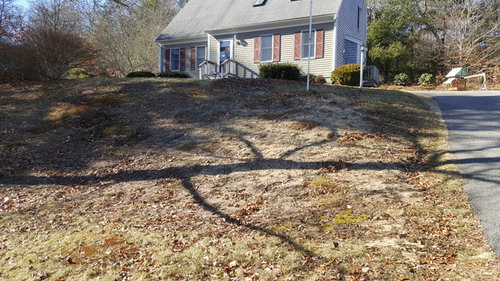
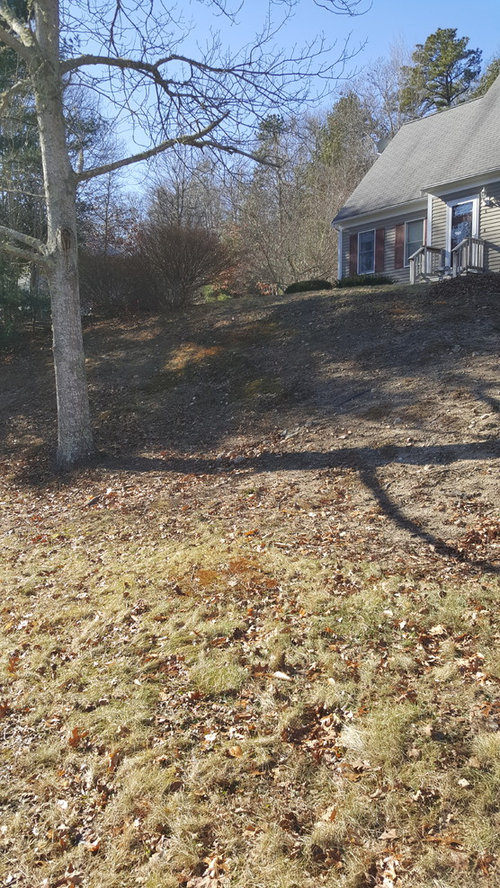
Comentarios (18)
Christopher CNC
hace 6 añosSloping.
A well built wall is always a nice feature. From your pictures I think a single groundcover on the slope below the house would work just fine. If you need more flat ground at front door level, that would take a wall.
Choose a good groundcover for your area. It looks like you are in the SE some where. Knowing better where you are will help people suggest good candidates.
User
hace 6 añosWhat do you mean when you say that mowing is not an option? You want all of the turf grass removed and replaced with something else?
Cathy F
Autor originalhace 6 añosmowing the hill is too difficult (and trecherous) would prefer another alternative.Christopher CNC
hace 6 añosÚltima modificación: hace 6 añosA groundcover that would work if the site is not too shady is Arctostaphylos uvi-ursi, bearberry.http://www.missouribotanicalgarden.org/PlantFinder/PlantFinderDetails.aspx?kempercode=j380
Sacred Roots Nursery
hace 6 añosPerhaps terracing the sloping area with several short retaining walls. The lowest area looks like it receives more sun and gradually gets more shady towards your house. What you'd like to plant depends entirely on your budget and your specific tastes. Keep in mind more flowers/perennials can come with extra maintenance than just a simple groundcover or shrubs. Personally I recommend to my clients a combination of shrubs, flowers and groundcover for the most aesthetic appeal.
emmarene9
hace 6 añosIn my opinion that area is too large to be covered entirely in one ground cover. Yes it can be done but it is not very appealing.
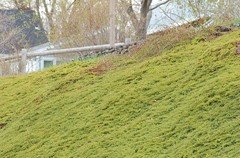 You could use low shrubs near the street. Then prostrate shrubs in the middle. Are you interest in any flat hardscape like a patio?
You could use low shrubs near the street. Then prostrate shrubs in the middle. Are you interest in any flat hardscape like a patio?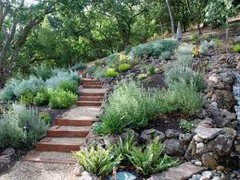
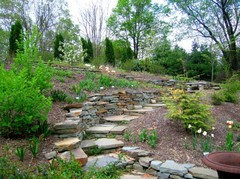
Christopher CNC
hace 6 añosHa ha Yardvaark. The haters are going to want a pound of flesh. That was the best defense of English Ivy I've ever read. Its biggest problem is that edge maintenance is neglected, abandoned or done poorly. And the fewer trees and shrubs planted in it the better.
emmarene9
hace 6 añosI live in a warm area, California. In my garden I could edge the English Ivy about four times a year. I am an avid gardener so some times I did it more often. I also sheared it in height. That meant it did not flower, so no concern of being spread by birds. I don't understand the scorn for a useful plant.
In the case of the OP I think English Ivy would have to be mowed which is not any different from grass.
cecily
hace 6 añosMy experience with ground cover is that it takes several seasons to grow dense enough to deter weeds and maple tree seedlings. In the meantime, the OP would need to weed it and that's a large area. If a wall or terrace is in the budget, I would include that and keep grass on the upper portion of the lawn.
l pinkmountain
hace 6 añosEh, your problem is shade and poor soil and competition from the tree's roots. Plant shade tolerant grass and apply a regular regime of compost and fertilizer and your grass might perk up, it did in my yard. Keep it simple. And yes, groundcover is another option and vinca might work also. And I also agree that both vinca and english ivy, for that large of an expanse, would look boring, particularly if that was all you had growing in the expanse. I had a hilly yard at my last house and it was covered with ground cover. You have to weed a groundcover and mine had to be sheared each summer after flowering, or it would get leggy, but it was less onerous to me than mowing. But my yard was urban and tiny.
If I had your yard, I would cut down that scraggly tree in the middle of the yard, improve my soil, wrap a border of low shrubs and wildflowers around the sides of the yard, with mulch underneath, maybe throw in a dogwood or crabapple or star magnolia for beauty, and then worry about the grass in the middle. Or, if I could afford it, I would have the yard terraced first.
Yardvaark
hace 6 años"The haters are going to want a pound of flesh." Oh, Christopher ... I have already given dozens of pounds of flesh on account of, and in defense of, English ivy. I will give more because I consider it to be in the top 5% of plants that are beautiful and serve hardworking utilitarian purposes ... and cause few problems IF ONE LEARNS TO MANAGE THEM! This is the sticking point because, by and large, haters do not wish to learn but prefer to keep hating.
"... I also sheared it [English ivy] in height." Emmarene, in a discussion (vicious argument) of long ago, it turned out that some California commenters were really lambasting Algerian ivy while calling it English ivy, and lumping the two together as if there were no difference. One of their complaints was this lumping up in height. Both may grow equally well in California. I don't know. I've never seen English ivy in the eastern US lump up in height as I've seen ivy doing this in California. It could be that only Algerian ivy is doing this. Or, if one is certain that they have English ivy and it is doing this, then there may be something about the west coast climate that creates it. I don't know. I just know it never happens over here. Unless English ivy is growing over a stump or other obstacle.
"My experience with ground cover is that it takes several seasons to grow dense enough to deter weeds ..." Cecily, this is not my experience with some groundcovers, English ivy in particular. I think quick coverage is a matter of timing and culture. I've grown English ivy from cuttings to transplants to full (but not thick) coverage in a single season by starting early, using close spacing (12" O.C.) and plenty of irrigation and some fertilizer. Regardless of whether or not one can duplicate this scenario, we still have thick mulch that acts as a weed deterrent until sufficient top growth is established.
It is generally a feature of those plants that are categorized as "groundcovers" that they are quick to cover. Many times their failure to do this is design (too wide spacing) or culture (poor care and maintenance.)
That a so called "large" expanse of a plant might be considered "boring" by some is certainly a subjective valuation. I think in most cases, it isn't until there is sufficient size achieved of a whatever thing, that it can be, or is, considered beautiful. Too small of elements are often "lost" in a landscape. Too many of such things begin to form a "busy" or confusing picture. It is when the picture is sufficiently bold and simple that its artistic message is easy to read and grasp and that it becomes powerful even when examined for only a brief period of time. The large, "boring" elements seem to attract people when they are not thinking about it .... the mountains .... the seashore ... expanses of manicured lawn, or fields, or forests of exact same trees.mad_gallica (z5 Eastern NY)
hace 6 añosHere, English ivy can take a severe hit from a cold/normal winter, and take surprisingly long to come back. My neighbor's have some, and it isn't something I'd recommend for zone 5 New England.
When using these forums, a good thing to keep in mind is that people located more than say 500 miles away often have little idea of what are good suggestions.
Christopher CNC
hace 6 añosEpic rant Yardvaark. You're da groundcover man. No more mulching covering the ground is coming back into fashion with the horticultural hoi polloi. I have a feeling you got there first.
l pinkmountain
hace 6 añosÚltima modificación: hace 6 añosI love large expanses of groundcover, but in and of themselves they are not necessarily aesthetic. Depends on setting and context. I stand corrected on my advice, don't cut down the tree, it looks better from the landscape view, just prune it to remove the dead branches. But as far as establishing groundcover, you might want to start around the tree and work outwards . . . just don't pile dirt up around the tree's trunk. I have a huge ugly sandy lawn that I am gradually turning over to groundcovers. I start by saving up lots of corrugated cardboard and then use that for landscape cloth. The great thing about that is it eventually decomposes and you don't have the problems you would with plastic landscape cloth. Then you can start little plugs of ground cover, and then cover the cardboard with mulch. The ground cover will gradually fill in and it will look good in the meantime and less weeds. I am starting with islands around my trees (cause they are a pain to mow under and grass doesn't grow well under them anyway), and am working my way out from there. Meanwhile, grass holds the soil in and helps make the yard look ok year-to-year as the mulched/ground cover areas gradually expand.
Yardvaark
hace 6 añosLikewise, Mad Gallica, E. ivy was a bare survivor, not a performer in my zone 5 birthplace. To be clear, it was not suggested as a solution here, since I don't even know where here is. (If mentioned, I forgot.) Talk referring to it was tangential to a discussion of groundcover in general, and as an example of groundcovers' behavior. I suggested OP look around locally to see what others were using in similar situations, but we have not heard back on that. It's sometimes true that people 500 miles away don't know plants in other zones, but not always true. I grew up in zone 5. Lived some in zone 6. A lot in zone 7/8 border area. And am now in zone 9. (There is a heat-seeking trend in my moves and I may not be entirely done.)

Volver a cargar la página para no volver a ver este anuncio en concreto
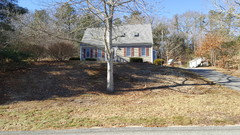
Yardvaark